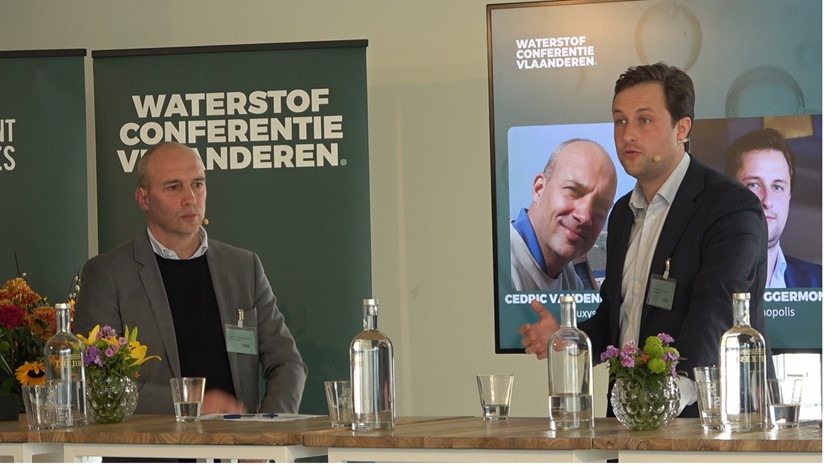Kristof graduated as a Master of Business Engineering at the University of Antwerp in 2018 (major in Corporate Finance and Financial engineering). In his master thesis, he examined the profitability of a momentum strategy on various government bond markets. Kristof joined the team of Econopolis as a Business Analyst in September 2018, focusing on data management and the follow-up of the latest wealth management technologies. Since 2020 Kristof, became Senior Consultant within Econopolis Consulting, a strategic advisory services with a focus on climate and energy transition.
The Future of Hydrogen Is Not Only Green
Econopolis Consulting attended the Flemish Hydrogen Conference on April 20, 2023. This annual event focuses on the latest developments, innovations, and applications of hydrogen technology, and brings together researchers, businesses, policymakers, and other stakeholders in the hydrogen industry to discuss and exchange ideas on the future of sustainable energy. Econopolis’ Senior Climate Consultant Kristof Eggermont participated in the debate on the strategic role of hydrogen in our industry. The panel tackled important questions, such as how will we meet our hydrogen needs, will the importation of hydrogen lead to new energy dependencies that will make us vulnerable, or what are the major bottlenecks today for a large-scale rollout of hydrogen in our industry?

Hydrogen is rapidly gaining recognition as an important climate solution, offering an alternative to fossil fuels in a wide range of applications. From fueling ships and aircrafts, to serving as feedstock in the chemical sector and enabling steel production, the possibilities are endless. However, it’s crucial to note that hydrogen is an energy carrier: it does not occur as a resource on Earth, but it is packaged in larger molecules, such as methane or water. Before diving deeper, it is good to go over the main hydrogen colors:
- Gray hydrogen: Hydrogen produced from natural gas. Most hydrogen is generated this way.
- Blue hydrogen: This is the product of gray hydrogen production, combined with CO2 capture and storage.
- Green hydrogen: Hydrogen produced via electrolysis from renewable energy sources, such as solar and wind.
- Pink hydrogen: Hydrogen produced via nuclear-based electrolysis.
The EU's hydrogen aspirations are enormous. Belgium and the EU have made it clear that green hydrogen is their preferred choice, however both keep the door slightly open for blue hydrogen. This option for blue hydrogen is not reflected in the EU's 2030 goals, which aims at respectively 10 million tons of green hydrogen being imported and 10 million tons of green hydrogen being locally produced. This is a daunting task, especially, when considering that the production capacity was a mere 109,000 tons last year. To achieve their objectives, the EU needs to increase its local electrolysis capacity 100-fold by 2030, which requires licensing and building new capacity.
Belgium and the Netherlands currently consume a total of 1.75 million tons of gray hydrogen, primarily for fertilizer production, refinery processes and methanol synthesis. Replacing just this gray hydrogen with green hydrogen would require approximately 90 terawatt hours of green power annually. However, the total power consumption of Belgium and the Netherlands is about 210 terawatt hours. That means both countries will have to increase their current power production by almost 45 percent if they want to green these applications alone. And it’s crucial to note that this doesn't even consider new applications for hydrogen.
We do not want to send a negative message. However, it is important to take the following three messages seriously, if we want to realize our hydrogen ambitions:
- Hydrogen will be a scarce resource in the coming decades, so we need to use it smartly.
- Large-scale hydrogen imports are inevitable but will not necessarily be a problem. Unlike fossil fuels, every country can harness energy from the sun and the wind. That will lead to less political manipulation and more balanced energy relations.
- We are going to need all clean forms of hydrogen. We have a lot to lose if we get too dogmatic about certain types of hydrogen colors at this stage. Instead, we should incentivize the production of all kinds of clean hydrogen varieties, including blue and pink hydrogen.
Hydrogen faces two major challenges in the coming years: 1) we must make the current production climate-neutral and 2) the production capacity must expand enormously. To successfully bring hydrogen to scale in the coming years, we must remain open to all forms of low-carbon hydrogen. Refusing to consider certain types of hydrogen could impede the pace of development in this sector and would also be detrimental to the development of green hydrogen.
We are well-positioned as a region to build a successful hydrogen ecosystem and become a technological pioneer. The US, with its Inflation Reduction Act, is now also jumping on the hydrogen train in full force. If we lose our lead position, hydrogen hubs will be developed elsewhere in the world. We need to work on infrastructure, legislation, and new hydrogen deals with solar and wind-rich countries. The next few years will be decisive.
If you or your company want to know more about hydrogen and its potential, don’t hesitate to reach out to our Climate Consulting team. We would be happy to assist you on your journey.